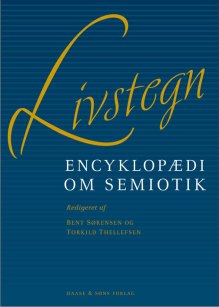Posted in book, people on January 4, 2007|
3 Comments »
 Semiotics, as you may or may not know, is a theory of meaning that holds that the worlds presents itself to us through signs. What is a sign? Well, in a basic sense it is the idea that some perceived part of the physical reality surrounding us – let us call this a “signifier” – acquires meaning by being coupled with some mental content; let us call this latter thing the “signified”. In other words, a sign is a function between a signifier and a signified. Take the word “dog”. As you read this word here on your computer screen, the visual input is related to a certain semantic category. As it so happens this semantic category can also be accessed by other signifiers, for instance the French word “chien”, or the Danish “hund”. In order to understand the meaning of “dog”, “chien”, or “hund” you have to know the rules linking signifier with signified.A basic problem in semiotics is how such rules arise and how they are instantiated. A particular branch of semiotics argues that rules are completely arbitrary and the product of social negotiation. That the signifier “dog” signifies a specific semantic category is due to the fact that some group of people collectively have decided to employ this semiotic rule. On the other hand, another group of semioticians argues that such rules are grounded in a basic isomorphism between the forms of the perceived world and our conceptual system. This “ground” is the very prerequisite for the formation of semiotic rules in the first place. How else would they get off the ground?
Semiotics, as you may or may not know, is a theory of meaning that holds that the worlds presents itself to us through signs. What is a sign? Well, in a basic sense it is the idea that some perceived part of the physical reality surrounding us – let us call this a “signifier” – acquires meaning by being coupled with some mental content; let us call this latter thing the “signified”. In other words, a sign is a function between a signifier and a signified. Take the word “dog”. As you read this word here on your computer screen, the visual input is related to a certain semantic category. As it so happens this semantic category can also be accessed by other signifiers, for instance the French word “chien”, or the Danish “hund”. In order to understand the meaning of “dog”, “chien”, or “hund” you have to know the rules linking signifier with signified.A basic problem in semiotics is how such rules arise and how they are instantiated. A particular branch of semiotics argues that rules are completely arbitrary and the product of social negotiation. That the signifier “dog” signifies a specific semantic category is due to the fact that some group of people collectively have decided to employ this semiotic rule. On the other hand, another group of semioticians argues that such rules are grounded in a basic isomorphism between the forms of the perceived world and our conceptual system. This “ground” is the very prerequisite for the formation of semiotic rules in the first place. How else would they get off the ground?
Unfortunately, there has not been a great interest among semiticians to test these assumptions through neuroscientific research. Roman Jakobson, one of the greatest semioticians of the 2oth Century, a few years before his death, said that had he been a young man he would have turned to neuroscience. To date, almost no semiotician has heeded this call.
On this note, let me mention two new semiotics publications. The first is an encyclopedia called Livstegn, written by 49 Danish researcers. (Sorry, this book is only available in Danish!) I contributed the entry on “neuroaesthetics”. Curiously it contains two entries on “neurosemiotics”. Curiously because, as I just wrote, there hardly exists any semiotic research taking its departure from neuroscience.
The second book is Frederik Stjernfelt‘s Diagrammatology, the first monograph to really consider the Peircean concept of “the diagram”. (This book is in English and is published by Springer, so everybody should be able to both get it and read it!) The interesting part about Stjernfelt’s book is that he relates Peirce’s idea of the diagram to both Husserlian phenomenology and modern cognitive linguistics – hence integrating a rather obscure semiotic concept into current discussions in cognitive science. I also know that Stjernfelt is interested in looking into the neurobiology of diagrams.
-Martin
Read Full Post »
 The third annual conference on imaging genetics was held at Irvine this January. Neither Thomas nor I could go this year, but people tell me it was just as great as previous years. Now you can tell for yourself: videos of all the presentations can now be watched via this web-site. Among the speakers are Lisa Eyler, David Goldstein, Steven Potkin, and Andreas Meyer-Lindenberg.
The third annual conference on imaging genetics was held at Irvine this January. Neither Thomas nor I could go this year, but people tell me it was just as great as previous years. Now you can tell for yourself: videos of all the presentations can now be watched via this web-site. Among the speakers are Lisa Eyler, David Goldstein, Steven Potkin, and Andreas Meyer-Lindenberg.
